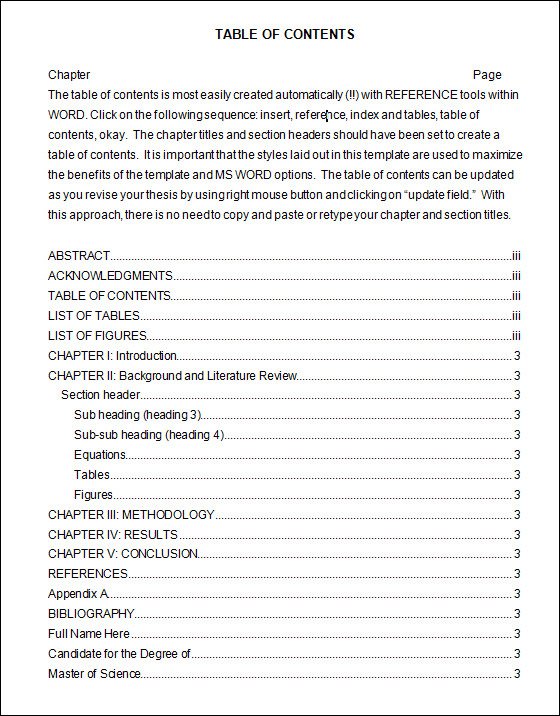
- #WORD 2016 TABLE OF CONTENTS TEMPLATE 2007 HOW TO#
- #WORD 2016 TABLE OF CONTENTS TEMPLATE 2007 UPDATE#
- #WORD 2016 TABLE OF CONTENTS TEMPLATE 2007 CODE#
Right align page numbers tells Word to justify the page numbers on the right edge of the page while ‘Tab Leader’ indicates what character to use between the TOC entry and the page number (to guide a readers eye along the line).įormatting can be done from the TOC styles in the current template or from some pre-defined options available in the drop-down list. Show Page Numbers: you can uncheck this option if your document is meant to be printed, for example our ebooks don’t have page numbers in the TOC but do use the ‘Use hyperlinks instead of page numbers’ to make each TOC line clickable and jump to that chapter. The term ‘Web Preview’ really means any non-paper form not just a HTML document. The two preview panes show how the current settings will look in printed form or online. If you right-click in a TOC field and choose Edit Field you get the standard Field codes edit box, scroll down to TOC in the Field Names then click on the Table of Contents button. Unless you dig into the details of the field codes, the way to change a Table of Contents is to replace it. Note: the use of the word ‘Table’ in the second option should not mislead you into thinking that the TOC is a Word table – it isn’t.
#WORD 2016 TABLE OF CONTENTS TEMPLATE 2007 UPDATE#
Certainly it’s a wise move to fully update the TOC before sending a document out. It rarely takes a noticeable time to update even on a long document. We prefer to use ‘Update entire table’ to ensure the TOC is fully up to date. This choice is faster but we generally avoid it because a change in the headings may be overlooked. The default is ‘update Page Numbers only’ which is fine if you’ve not changed or moved any headings and only added or removed text.
#WORD 2016 TABLE OF CONTENTS TEMPLATE 2007 HOW TO#
However we’ve copied the TOC field parameters below if you’re interested.īut it’s important to understand how the TOC works so that you know how to update it.Īs with any field, pressing F9 will update the field, but if you do that with a TOC you’ll get the choice to:
#WORD 2016 TABLE OF CONTENTS TEMPLATE 2007 CODE#
Thankfully you should never need to worry about the field code parameters – the menu gives you access to all the options. Press Alt+F9 to reveal the field codes in any Word document, press a second time to return to standard view. The Table of Contents is a Word field code – the Word 2003 default looks like this: Just go through your document and adjust the styles accordingly. If you just click OK you’ll get a standard TOC showing headings from ‘Heading 1′, Heading 2′ and Heading 3’.Ĭhances are you’ll notice some anomalies in your initial TOC – headings missing or items that should not be there. Word 2007 has it under the ‘References’ tab on the ribbon. In Word 2003 you’ll find it under Insert | Reference | Index and Tables | Table of Contents.
.svg/1200px-Microsoft_Office_Word_(2019–present).svg.png)
The basics haven’t changed much for many versions of Word.

Once you’ve got some headings formatted in your document you can make a Table of Contents. If you haven’t already, go through your document applying Heading styles to heading and sub-headings. That’s the easy way however you can assign any paragraph style to a level in the TOC. Normally you’ll use the ‘Heading 1’, ‘Heading 2’ etc styles in Word to define the headings that you want to show in the Table of Contents. Word takes the text from paragraphs in nominated styles to make up the TOC.


Preparing your documentīefore you make your Table of Contents (aka TOC) you need to setup your document with headings that will make up the TOC. It’s a good way to see an overview of a long document and ensure that it’s in a logical structure.įinally it can be a way to jump to parts of the document if you don’t like using the Document Map feature in Word. A table of contents can be there for ‘in house’ use while making the document, and later removed from the final version. It’s very easy to do this in Word and it’s not just for people who are making books, for it can be useful in any long document such as a contract. In this issue we’ll look at the basic options for making a Table of Contents in a Word document. The basic options for making a Table of Contents in a Word document.


 0 kommentar(er)
0 kommentar(er)
